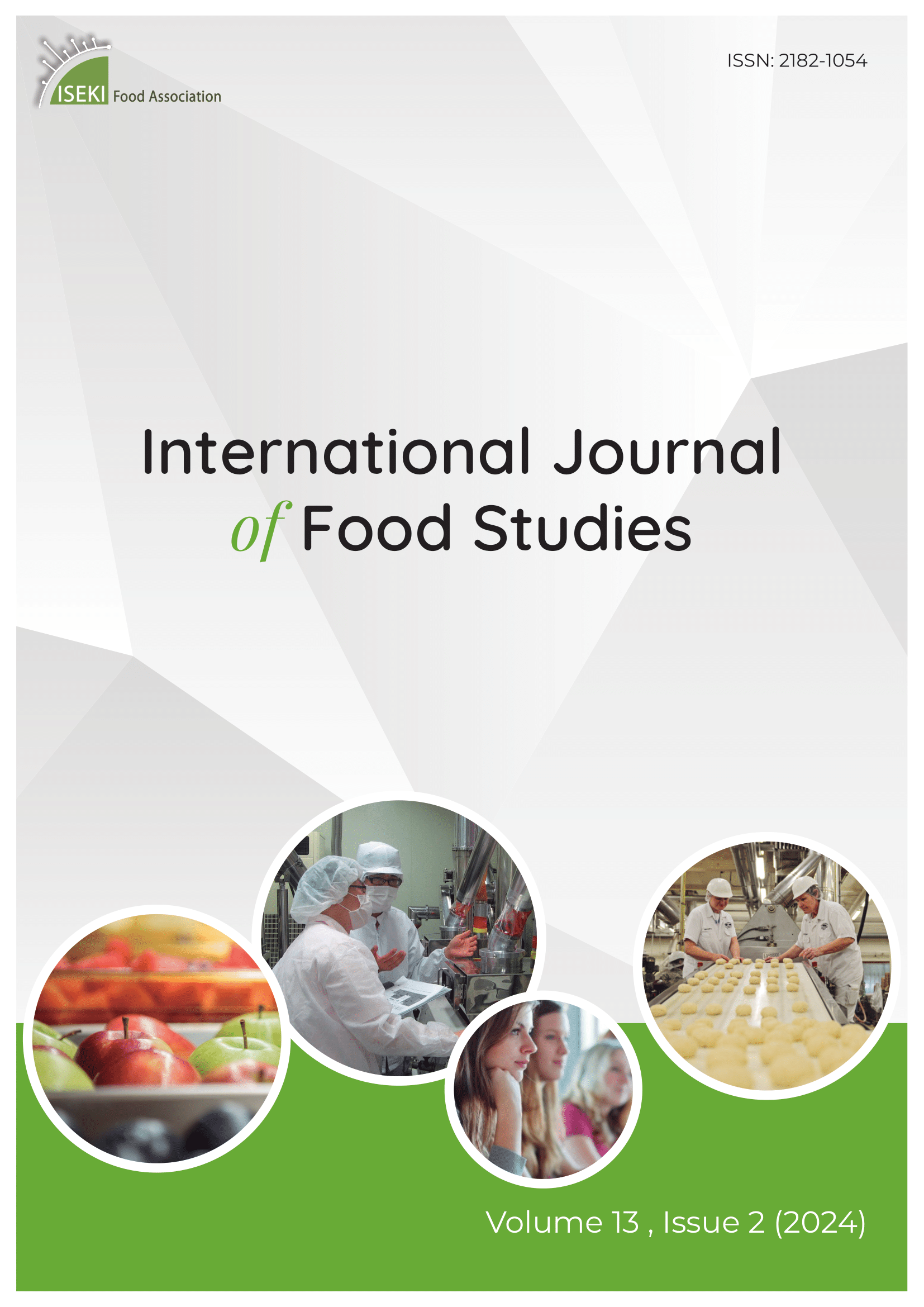Current issue

Volume 13, Issue 2, 2024
Online ISSN: 2182-1054
Volume 13 , Issue 2, (2024)
Published: 18.10.2024.
Open Access
All issues
Contents
18.10.2021.
Original scientific paper
Effect of varying levels of acorn flour on antioxidant, staling and sensory properties of Iranian toast
Due to the high level of antioxidant activity of acorn fruits, they can be used as an ingredient the production of functional foods. The goal of the this research was to partially substitute wheat flour with varying levels (10% - 50% w/w) of debittered acorn flour and to investigate its effects on the rheological characteristics of the dough, total phenolic content (TPC), staling, colour indices and sensory properties of toast bread. The farinograph degree of softening and water absorption of the dough decreased with increasing the acorn flour content, while the stability and time of development of the dough increased. Resistance and extensibility to deformation of the samples respectively increased and decreased compared to those of the control. Toast bread with 30% acorn flour replacement was observed to have lower staling than the control. The highest TPC (9.44 mg GAE/g) and the lowest peroxide value (0.36 m eq O2/kg) were obtained for the bread having 30% acorn flour substitution. Moreover, the breads showed darker crumbs with significantly lower specific loaf volumes. Overall, the bread with 30% of acorn flour substitution showed good rheological, staling properties and reasonable anti-oxidant content compared to the control bread as well as the highest sensorial acceptability.
Babak Mousavi, sajad ghaderi, Mohammad Ali Hesarinejad, Azizollah Pourmahmoudi
18.05.2021.
Original scientific paper
Influence of Raw Meat Content on 3D-Printing and Rheological Properties
The aim of this study was to investigate the influence of raw chicken meat content on the rheological properties and 3D printability of minced meat mixtures using different concentrations of raw and cooked chicken meat. The meat mass contained yolk, crushed ice, lean raw meat and cooked meat with a high concentration of connective tissue. The concentrations of raw meat added to cooked meat as a percentage of the total weight of meat were 0; 30; 40; 50; 60; 70 and 100. To determine the rheological properties, amplitude sweep and frequency sweep were carried out with a Rheostress RS 300 (Thermo Fisher Scientific Inc.). Cubes were printed, and the printability and optical impression were evaluated using grades from 1-5. The results showed that rheological properties had a strong influence on the printability of meat mass and it is necessary for G' (storage modulus) at the LVR (linear viscoelastic region) to be higher than 7000 Pa. The complex viscosity |η*| should be higher than 170 Pa, at a shear stress τ = 10 Pa, and a frequency f = 10 Hz used to guarantee sufficient solidity.
Marius Herold, Sören Morick, Oliver Hensel, Uwe Grupa
18.04.2021.
Original scientific paper
Continuous Stirred Tank Reactor: A Process Design for Interesterification of Macauba (Acrocomia aculeata) palm oil
Other than the edible oils extracted from the Acrocomia aculeata fruit, there is a growing interest in the palm to generate other high value-added products. Relatively high amounts of carotenoids (up to 378 mg kg-1) have been found in the esculent oils mechanically obtained from the fruit mesocarp. From industrial application perspectives, several processes have been proposed to modify native vegetable oils to yield high functional properties of structured lipids. For interesterified products, the thermal effects of industrial reactors are crucial in reaction mechanisms. The present study has taken into account previously estimated kinetic parameters for the overall disappearances of all-trans β-carotene in the Acrocomia aculeata oil (ko= 2.6 x 10-4 min-1; Ea = 105.0003 kJ mol-1; ΔH = 9.8 x 104 J kg-1) to develop a continuous stirred tank reactor (CSTR) kinetic treatment that obeys first-order kinetics. A system of ordinary dierential equations - mass and energy balances - was solved by the 4th order Runge-Kutta method (GNU Octave software). Under research conditions related to interesterification processing (2 h; 393.15 K), the initial concentration of carotenoids (around 11%) showed no significant decrease. Overall, realistic processing effects and conditions have been assessed, integrating results and knowledge, improving prospects of Acrocomia aculeata as a promising source of high-quality raw material, for producing functional ingredients and food with nutraceutical properties.
Pedro Valério, Isabella Fonseca Araujo, Juan Canellas Bosch Neto, Jesus Maria Frias Celayeta, Erika Cristina Cren
18.05.2021.
Original scientific paper
Functional and Pasting Properties of Gari Produced from White-fleshed Cassava Roots as Affected by Packaging Materials and Storage Periods, and Sensory Attributes of the Cooked Gari Dough (eba)
Gari (roasted fermented cassava grits) is the most popular product consumed in West Africa and an important food product in the diet of millions of people in developing countries. The study investigated the effect of packaging materials (PM) and storage periods on the functional and pasting properties of Gari produced from white-fleshed cassava roots and sensory attributes of the cooked Gari dough (eba). Gari was produced using the standard method and packaged in a polypropylene woven sack (PP) and polyvinyl chloride container (PVC). Gari was stored for 24 weeks at room temperature and sampled at four-week intervals for functional and pasting properties, and sensory evaluation of the eba, using standard methods. The results showed that the storage periods significantly affected all the functional (except swelling power) and pasting properties of the Gari, and PM had no significant (p>0.05) effect on the functional (except bulk density) and pasting properties. Also, the PM had no significant effect on the sensory attributes of the eba except for the mouldability (p<0.05). The setback viscosity of the Gari packaged in PVC had a significant (p<0.05, r= -0.58) negative correlation with the texture of the eba. The panellists preferred all the sensory attributes of the eba made from the Gari stored in PP compared to that made from Gari stored in PVC. Therefore, packaging Gari in PP may keep most of the properties preferred by consumers when stored for up to 5 months.
Wasiu Awoyale, Hakeem Oyedele, Busie Maziya-Dixon
18.10.2021.
Original scientific paper
Response surface analysis and process optimization of non-cereal (elephant foot yam, taro and water chestnut) snacks
The present study was conducted to develop non-cereal starch extruded products. The effects of feed moisture (15-21%), temperature (130-170 °C) and screw speed (120-160 rpm) were evaluated on the physical and functional properties of extruded snacks using response surface methodology. Feed moisture and screw speed increased the bulk density and hardness of extruded snacks. Significant decreases in water absorption index and increases in water solubility index were observed with increases in extrusion temperature. The best conditions were determined by numerical optimization. The optimized value for non-cereal snacks for feed moisture is 18.22%, temperature 155.96 °C, screw speed 142.75 rpm and, desirability is 0.75. Verification of results showed decent agreement between the responses of experimental values at certain optimum conditions and the predicted values.
Anuj Saklani, Ravinder Kaushik, Krishan Kumar
18.05.2021.
Original scientific paper
Applications of High Pressure Technology in Food Processing
Consumer trends towards shelf-stable, safe, more natural and free from additives foods drove the need to investigate the commercial application of non-thermal food processing technologies. High pressure processing (HPP) is one such emerging technology where foods are generally subjected to high pressure (100-1000 MPa), with or without heat. Similar to heat pasteurization, HPP deactivates pathogenic microorganisms and enzymes, extends shelf life, denatures proteins, and modifies structure and texture of foods. However, unlike thermal processing, HPP can retain the quality of fresh food products, with little or no impact on nutritional value and organoleptic properties. Moreover, HPP is independent of the geometry (shape and size) of food products. The retention of food quality attributes, whilst prolonging shelf life, are enormous benefits to both food manufacturers and consumers. Researches have indicated that the combination of HPP and other treatments, based on the hurdle technology concept, has potential synergistic effects. With further advancement of the technology and its large-scale commercialization, the cost and limitations of this technology will probably reduce in the near future. The current review focuses on the mechanism and system of HPP and its applications in the processing of fruit, vegetables, meat, milk, fish and seafood, and eggs and their derived products.
K. R. Jolvis Pou
18.05.2021.
Original scientific paper
Thermal Degradation of β-Carotene from Macauba Palm: Mathematical Modeling and Parameter Estimation
Worldwide, there is a current need for new sources of vegetable oils. The natural content of total carotenoids in Acrocomia aculeata palm oil (up to 378 µg.g-1) surpasses that of many other tropical fruits, making it one of its main compositional characteristics. As far as can be verified, there is no available information on the degradation kinetics of carotenoids for A. aculeata oil, which is required to describe reaction rates and to predict changes that can occur during food processing. The present study considered prediction abilities that have emerged with the use of specific kinetic data and procedures to understand thermal processing better, as an essential unity operation. Two kinetic mechanisms were proposed to describe the overall thermal degradation of carotenoids in the oil; the first one consists of three reaction steps while the other presents only one-step reaction. Mass balance equations were numerically solved by a Backward Differentiation Formula technique. The kinetic parameters from both models were estimated through a hybrid optimisation method using the Particle Swarm Optimization and the Gauss-Newton method, followed by statistical analyses. The model with more than one reaction was shown to be overparameterized and was discarded. The model with a single reaction was highly suited to handle the experimental data available, and the dependency of its rate constant on temperature was expressed according to Arrhenius law. As far we know, this is the first time the kinetics of carotenoids thermal degradation in A. aculeata oil is investigated through modelling simulation.
Pedro Prates Valério, Amanda Lemette Brandão, Jesus Maria Frias Celayeta, Erika Cristina Cren
18.05.2021.
Original scientific paper
Production and characterization of emulsified fish mortadella from Nile tilapia (Oreochromus niloticus)
This study produced fish mortadella from Mechanically Separated Meat (MSM) of Nile tilapia added with animal fat. Three formulations were developed: M1 (MSM - 89 % and 5 % pork fat), M2 (MSM - 84 % and 10 % pork fat) and M3 (MSM - 79 % and 15 % pork fat). The elaborated products were tested for technological, physical, physico-chemical, microbiological and sensory parameters. The results showed that the fish mortadella were microbiologically stable with a particular texture for an emulsified meat product, attractive colour and characteristic flavour. All formulations met the expected identity and quality requirements. They also achieved good acceptance by the judges, in which formulation M1 may be highlighted for presenting an emulsion stability of 97 %, higher protein content (18.09 %) and lower lipids (16.31 %). In addition, it also reached higher mean scores for texture attributes and purchase intent. Therefore, it is possible to prepare fish mortadellas from tilapia MSM using less animal fat.
Heloísa Maria Ângelo Jerônimo, Maria Elieidy Gomes de Oliveira, Carlos Eduardo Vasconcelos de Oliveira, Natália Ferrão Castelo Branco Melo, Alex Poeta Casali, Antônio Rosendo da Costa, Aryane Ribeiro da Silva, Ricácia de Sousa Silva, Tânia Stamford
18.04.2021.
Original scientific paper
Reduced Meat Consumption: from Multicriteria Argument Modelling to Agent-Based Social Simulation
A second nutrition transition seems to be emerging towards more plant-based diets, curbing meat consumption in developed countries at the beginning of the 21st century. This shift suggests that rational arguments tend to influence an increasing number of individuals to adopt vegetarian diets. This work aimed to understand and simulate the impact of different types of messages on the choice to change food diets at the individual level, and the impact of the diffusion of opinions at the collective level. It provided two results: (1) a network of arguments around vegetarian diets is modelled using an abstract argumentation approach. Each argument, formalized by a node, was connected with other arguments by arrows, thus formalizing relationships between arguments. This methodology made it possible to formalize an argument network about vegetarian diets and to identify the importance of health arguments compared to ethical or other types of arguments. This methodology also identified key arguments as a result of their high centrality in being challenged or challenging other arguments. The results of constructing this argument network suggested that any controversy surrounding vegetarian diets will be polarized around such high centrality arguments about health. Even though few ethical arguments appeared in our network, the health arguments concerning the necessity or not of animal products for humans were indirectly connected with ethical choices towards vegetarian diets; (2) an agent-based simulation of the social diffusion of opinions and practices concerning meat consumption is then introduced. The purpose of this simulation was to capture the balance of vegetarian vs. meat-based diets. It contributes to modelling consumer choices by exploring the balance between individual values and external influences such as social pressure, communication campaigns and sanitary, environmental or ethical crises.
Rallou Thomopoulos, Nicolas Salliou, Carolina Abreu, Vincent Cohen, Timothée Fouqueray
18.10.2021.
Original scientific paper
Effect of storage on physico-chemical, microbiological and sensory characteristics of goat milk fermented by Lactobacillus strains isolated from minas artisanal cheeses
Lactobacillus spp. are lactic acid bacteria which have important implications for the food industry due to their fermentation capacities. The aims of this research were to produce fermented goat milks with Lactobacillus plantarum B7 and Lactobacillus rhamnosus D1, isolated from Brazilian artisanal cheeses, and to evaluate their physico-chemical, microbiological and sensorial qualities during 30 days of storage at 7°C. The goat milks, fermented by B7, D1, co-culture and a Lactobacillus casei Shirota control, possessed acceptable physico-chemical characteristics to meet fermented milk standards established by Brazilian legislation and maintain the viability of Lactobacillus spp. throughout the shelf life of the products. The products were microbiologically safe. D1 fermented goat milk gave higher consumer sensory quality acceptance and purchase intention (p<0.05) than other treatments, thus Lactobacillus rhamnosus D1 is recommended for fermented goat milk production.
Gustavo Valente, Leonardo B. Acurcio, Ranier C. Figueiredo, Felipe M. Sant'Anna, Rommel F. Brito, Luigi P. V. Freitas, Andréia M. Silva, Marcelo R. Souza, Cláudia F. A. M. Penna











